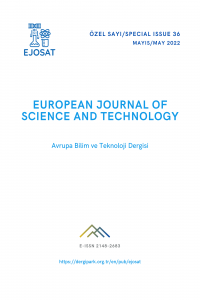Ağ Trafiğinin Akış Tabanlı Sınıflandırılmasında Akış Sürelerinin Makine Öğrenimi Algoritmalarına Etkisi
Öz
Günümüzde ağ trafiği verilerinin kontrol altında olması önemli bir gerekliliktir. Ağ operasyonlarının başarısı, belirlenen hedeflere yönelik ağ trafiği sınıflandırılmasının doğru ve performanslı bir şe kilde gerçekleştirilmesine bağlıdır. Ağ trafiği sınıflandırılmasında sıklıkla istatiksel bir yaklaşım olan akış tabanlı yöntemler kullanılmaktadır. Bu çalışmada, farklı akış sürelerinde oluşan ağ akışlarının makine öğrenimi algoritmaları üzerindeki etkileri incelemiştir. AdaBoost, DecisionTree ve RandomForest makine öğrenmesi algoritmalarının ağ trafiği sınıflandırılmasında akış tabanlı yöntem ile farklı akış sürelerinde sınıflandırma performansları analiz edilmiştir. Elde edilen sonuçlara göre makine öğrenmesi algoritmalarının ağ akışı süresinden önemli ölçüde etkilendikleri tespit edilmiştir.
Anahtar Kelimeler
Ağ trafiği sınıflandırılması Akış tabanlı yöntem Makine öğrenmesi.
Kaynakça
- Aouini, Z., & Pekar, A. (2022). NFStream. Computer Networks, 204, 108719. https://doi.org/10.1016/j.comnet.2021.108719
- Cherif, I. L., & Kortebi, A. (2019). On using extreme gradient boosting (XGBoost) machine learning algorithm for home network traffic classification. 2019 Wireless Days (WD). https://doi.org/10.1109/wd.2019.8734193
- Datta, J., Kataria, N., & Hubballi, N. (2015). Network traffic classification in encrypted environment: A case study of Google hangout. 2015 Twenty First National Conference on Communications (NCC). https://doi.org/10.1109/ncc.2015.7084879
- Draper-Gil, G., Lashkari, A. H., Mamun, M. S., & A. Ghorbani, A. (2016). Characterization of encrypted and VPN traffic using time-related features. Proceedings of the 2nd International Conference on Information Systems Security and Privacy. https://doi.org/10.5220/0005740704070414
- Gómez, S. E., Martínez, B. C., Sánchez-Esguevillas, A. J., & Hernández Callejo, L. (2017). Ensemble network traffic classification: Algorithm comparison and novel ensemble scheme proposal. Computer Networks, 127, 68-80. https://doi.org/10.1016/j.comnet.2017.07.018
- Statista. (2022, April). Global digital population as of April 2022 (in billions). https://www.statista.com/statistics/617136/digital-population-worldwide/
- World Development Report (WDR) Team. (2021). How big are global data flows? https://wdr2021.worldbank.org/stories/crossing-borders/
- Yamansavascilar, B., Guvensan, M. A., Yavuz, A. G., & Karsligil, M. E. (2017). Application identification via network traffic classification. 2017 International Conference on Computing, Networking and Communications (ICNC). https://doi.org/10.1109/iccnc.2017.7876241
- Zhang, J., Chen, X., Xiang, Y., Zhou, W., & Wu, J. (2015). Robust network traffic classification. IEEE/ACM Transactions on Networking, 23(4), 1257-1270. https://doi.org/10.1109/tnet.2014.2320577
- Zhang, J., Xiang, Y., Wang, Y., Zhou, W., Xiang, Y., & Guan, Y. (2013). Network traffic classification using correlation information. IEEE Transactions on Parallel and Distributed Systems, 24(1), 104-117. https://doi.org/10.1109/tpds.2012.98
The Effect of Flow Times on Machine Learning Algorithms in Flow-Based Classification of Network Traffic
Öz
Today, it is an important requirement to have network traffic data under control. The success of network operations depends on the accurate and performance classification of network traffic for the determined targets. Flow-based methods, which are a statistical approach, are often used in network traffic classification. In this study, the effects of network flows occurring at different flow times on machine learning algorithms are examined. The classification performances of AdaBoost, DecisionTree and RandomForest machine learning algorithms at different flow times have been analyzed with the flow-based method in network traffic classification. According to the results obtained, it has been determined that machine learning algorithms are significantly affected by the network flow time.
Anahtar Kelimeler
Network traffic classification Flow-based method Machine learning
Kaynakça
- Aouini, Z., & Pekar, A. (2022). NFStream. Computer Networks, 204, 108719. https://doi.org/10.1016/j.comnet.2021.108719
- Cherif, I. L., & Kortebi, A. (2019). On using extreme gradient boosting (XGBoost) machine learning algorithm for home network traffic classification. 2019 Wireless Days (WD). https://doi.org/10.1109/wd.2019.8734193
- Datta, J., Kataria, N., & Hubballi, N. (2015). Network traffic classification in encrypted environment: A case study of Google hangout. 2015 Twenty First National Conference on Communications (NCC). https://doi.org/10.1109/ncc.2015.7084879
- Draper-Gil, G., Lashkari, A. H., Mamun, M. S., & A. Ghorbani, A. (2016). Characterization of encrypted and VPN traffic using time-related features. Proceedings of the 2nd International Conference on Information Systems Security and Privacy. https://doi.org/10.5220/0005740704070414
- Gómez, S. E., Martínez, B. C., Sánchez-Esguevillas, A. J., & Hernández Callejo, L. (2017). Ensemble network traffic classification: Algorithm comparison and novel ensemble scheme proposal. Computer Networks, 127, 68-80. https://doi.org/10.1016/j.comnet.2017.07.018
- Statista. (2022, April). Global digital population as of April 2022 (in billions). https://www.statista.com/statistics/617136/digital-population-worldwide/
- World Development Report (WDR) Team. (2021). How big are global data flows? https://wdr2021.worldbank.org/stories/crossing-borders/
- Yamansavascilar, B., Guvensan, M. A., Yavuz, A. G., & Karsligil, M. E. (2017). Application identification via network traffic classification. 2017 International Conference on Computing, Networking and Communications (ICNC). https://doi.org/10.1109/iccnc.2017.7876241
- Zhang, J., Chen, X., Xiang, Y., Zhou, W., & Wu, J. (2015). Robust network traffic classification. IEEE/ACM Transactions on Networking, 23(4), 1257-1270. https://doi.org/10.1109/tnet.2014.2320577
- Zhang, J., Xiang, Y., Wang, Y., Zhou, W., Xiang, Y., & Guan, Y. (2013). Network traffic classification using correlation information. IEEE Transactions on Parallel and Distributed Systems, 24(1), 104-117. https://doi.org/10.1109/tpds.2012.98
Ayrıntılar
| Birincil Dil | Türkçe |
|---|---|
| Konular | Mühendislik |
| Bölüm | Makaleler |
| Yazarlar | |
| Erken Görünüm Tarihi | 11 Nisan 2022 |
| Yayımlanma Tarihi | 31 Mayıs 2022 |
| Yayımlandığı Sayı | Yıl 2022 Sayı: 36 |

